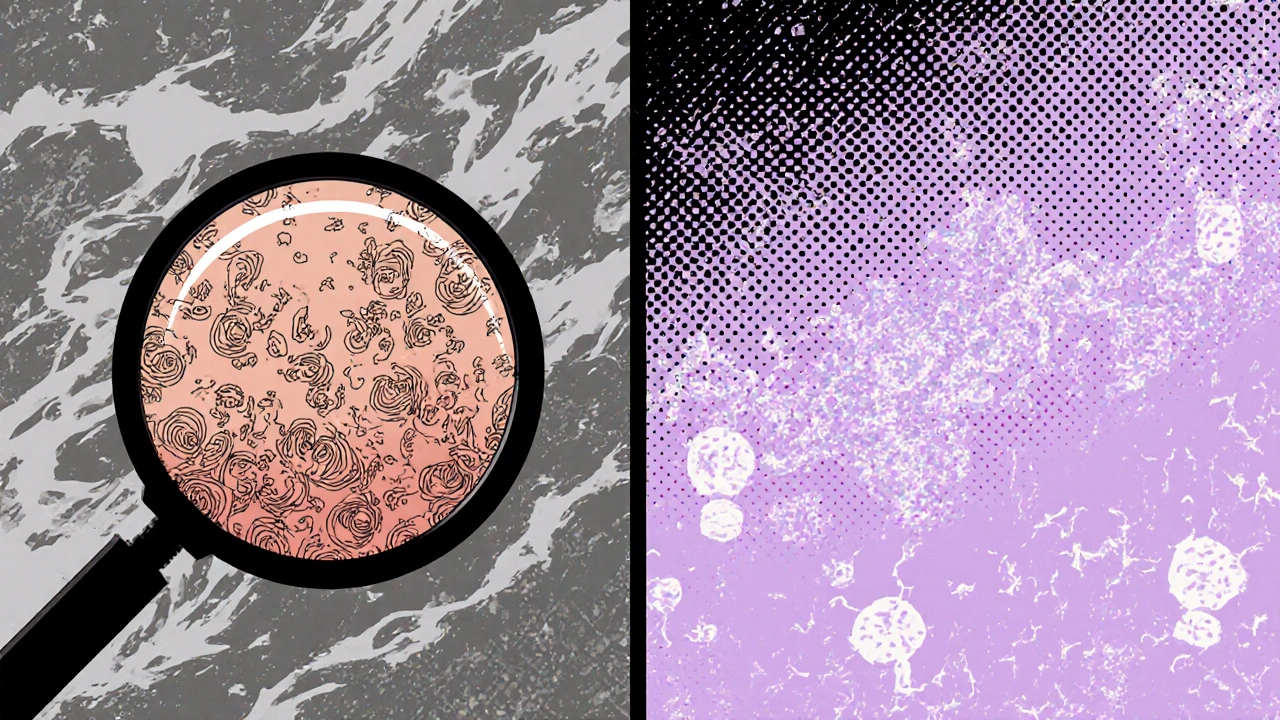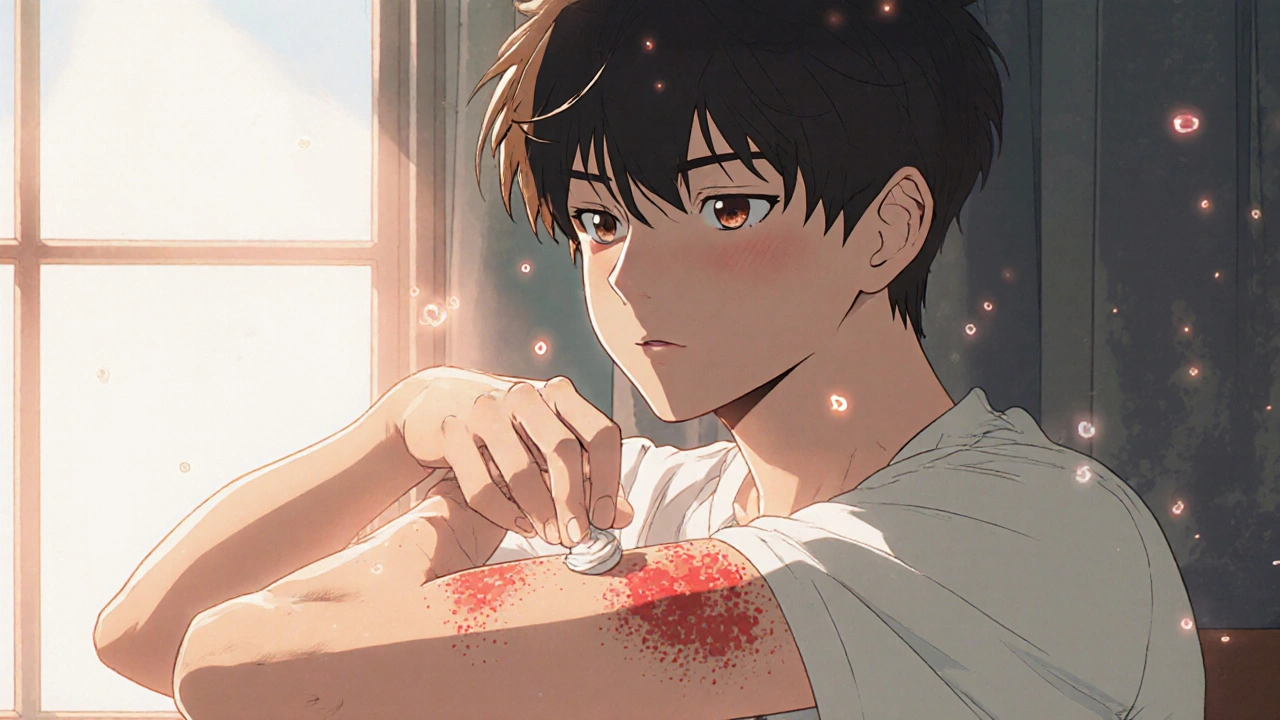Psoriasis isn’t just a rash. For millions of people, it’s a constant battle - flaky, itchy, sometimes painful patches that won’t go away no matter how much you moisturize. If you’ve tried over-the-counter creams and still see red, scaly skin on your elbows, knees, or scalp, you might have heard about calcipotriene. It’s not a cure, but for many, it’s the most reliable tool doctors prescribe to bring psoriasis under control.
What calcipotriene actually does
Calcipotriene is a synthetic version of vitamin D3. It doesn’t work like a steroid, which simply shuts down inflammation. Instead, it tells your skin cells to behave normally. In psoriasis, skin cells grow too fast - they pile up on the surface in days instead of weeks. Calcipotriene slows that process down. It also helps reduce the redness and scaling that come with it.
It’s applied directly to the skin, usually once or twice a day. The cream, ointment, or solution is absorbed right where you need it. That means fewer side effects than pills or injections. And unlike some treatments, it doesn’t thin the skin with long-term use.
How effective is it?
Clinical studies show that about 60% to 70% of people using calcipotriene see noticeable improvement within four to eight weeks. For some, the plaques shrink by half or more. Others notice less itching and less flaking after just a few days.
A 2023 review in the British Journal of Dermatology found that calcipotriene was as effective as low-to-mid strength corticosteroids for mild to moderate plaque psoriasis - but with a better safety profile. That’s why many dermatologists start with it, especially for long-term management.
Who should use it?
Calcipotriene works best for plaque psoriasis - the most common type, with thick, raised patches. It’s approved for adults and children over 12. It’s not meant for scalp psoriasis unless it’s in a special solution form, and it shouldn’t be used on the face or genitals unless your doctor says so.
If you have psoriasis covering more than 20% of your body, calcipotriene alone won’t be enough. It’s often paired with other treatments like corticosteroids, phototherapy, or systemic drugs. But for smaller areas - say, one elbow or a patch on your lower back - it’s often all you need.
What to expect when you start using it
When you first apply calcipotriene, your skin might sting or burn a little. That’s normal. It usually fades after a few days. If the burning lasts more than a week, or if your skin becomes very red or swollen, stop using it and talk to your doctor.
You won’t see results overnight. Most people notice changes after two weeks. Full improvement takes six to eight weeks. Don’t give up too soon. Consistency matters more than how much you apply. A thin layer is enough. Using more won’t make it work faster - it just raises your risk of side effects.

Side effects and safety
Calcipotriene is generally well tolerated. The most common side effects are mild: itching, dryness, redness, or peeling at the application site. These are signs your skin is adjusting, not failing.
One rare but serious risk: too much calcipotriene can raise calcium levels in your blood. That’s why you shouldn’t use more than 100 grams per week. Most people use far less - a pea-sized amount for each patch the size of your palm. If you’re using it on large areas, your doctor may check your blood calcium levels after a few months.
It’s safe to use during pregnancy, but only under medical supervision. There’s no evidence it harms the baby, but your doctor will weigh the benefits against any potential risk.
How to use it correctly
Here’s a simple routine:
- Wash and dry the affected area gently.
- Squeeze out a small amount - about the size of a pea for each patch.
- Apply a thin layer, rubbing it in until it disappears.
- Wait at least 15 minutes before applying moisturizer or sunscreen.
- Wash your hands after applying, unless you’re treating your hands.
- Use it once or twice daily, as prescribed.
Don’t cover the area with bandages unless your doctor tells you to. Occlusion can increase absorption and raise the risk of side effects.
What to avoid
Don’t use calcipotriene with other vitamin D-based treatments - that can lead to too much vitamin D in your system. Avoid combining it with strong corticosteroids unless your doctor specifically prescribes a combination product like Dovobet.
Also, skip sunlamps or tanning beds while using calcipotriene. Even though it’s not a photosensitizer, extra UV exposure can irritate psoriasis-prone skin and increase the chance of burning.
When to switch treatments
If you’ve used calcipotriene daily for 8 weeks and see no improvement, it’s time to talk to your dermatologist. You might need a stronger treatment - maybe a combination product, phototherapy, or an injectable biologic.
But don’t stop calcipotriene suddenly if it’s working. Stopping abruptly can trigger a rebound flare. If your doctor wants you to stop, they’ll guide you on how to taper off safely.

Real-life results
A 42-year-old teacher from Bristol started using calcipotriene on her elbows after years of trying lotions and steroid creams that left her skin thin and bruised. Within six weeks, the thick scales were gone. Her skin felt smoother. She still uses it twice a week as maintenance - just enough to keep flares from coming back.
Another patient, a 19-year-old student, used it for scalp psoriasis. The solution form didn’t leave his hair greasy. He applied it at night, washed it off in the morning, and within a month, his scalp was clear. He now keeps a small tube in his bag for emergencies.
Calcipotriene vs. other treatments
Here’s how it stacks up against common psoriasis options:
| Treatment | How it works | Time to see results | Best for | Common side effects |
|---|---|---|---|---|
| Calcipotriene | Slows skin cell growth, reduces scaling | 4-8 weeks | Mild to moderate plaque psoriasis | Stinging, dryness, mild irritation |
| Corticosteroids | Reduces inflammation quickly | 1-2 weeks | Quick relief for flare-ups | Thinning skin, stretch marks, rebound flares |
| Coal tar | Slows skin cell turnover | 4-12 weeks | Scalp or stubborn plaques | Staining, odor, greasy feel |
| Tazarotene | Retinoid that normalizes skin cell growth | 6-12 weeks | Thick plaques, resistant cases | Severe irritation, sun sensitivity |
| Biologics | Targets immune system overactivity | 4-16 weeks | Severe or widespread psoriasis | Infection risk, injection reactions |
Calcipotriene doesn’t work fast, but it’s safe for long-term use. Steroids work quicker but can’t be used daily for months. Biologics are powerful but expensive and require injections. For most people with mild to moderate psoriasis, calcipotriene hits the sweet spot: effective, affordable, and sustainable.
What’s next if calcipotriene isn’t enough?
If calcipotriene doesn’t clear your skin, your dermatologist might suggest:
- Combining it with a low-dose steroid in one cream (like Dovobet)
- Adding phototherapy - UVB light treatments twice a week
- Switching to a newer topical like tapinarof, which works differently but has fewer side effects
- Trying an oral medication like methotrexate or apremilast
- Starting a biologic if your psoriasis is affecting your quality of life
The goal isn’t to eliminate psoriasis completely - that’s rarely possible. It’s to keep it under control so it doesn’t control you.
Can calcipotriene cure psoriasis?
No, calcipotriene cannot cure psoriasis. Psoriasis is a chronic autoimmune condition, meaning it’s caused by your immune system attacking your skin. Calcipotriene helps manage the symptoms by slowing down skin cell growth and reducing scaling. It’s a maintenance tool, not a cure. Many people use it long-term to keep flares under control.
Is calcipotriene safe for long-term use?
Yes, calcipotriene is generally safe for long-term use, especially when used as directed. Unlike corticosteroids, it doesn’t cause skin thinning or stretch marks with prolonged use. However, using more than 100 grams per week can raise blood calcium levels, so stick to the prescribed amount. Most people use far less - a pea-sized amount per patch is enough.
Can I use calcipotriene on my face?
Usually not. Calcipotriene can irritate sensitive facial skin and may cause redness or burning. If you have psoriasis on your face, your doctor may recommend a gentler alternative like a low-potency steroid or a non-steroidal topical like tacrolimus. Some specially formulated low-concentration calcipotriene solutions may be used under strict supervision, but never without medical advice.
How does calcipotriene compare to coal tar?
Both slow skin cell growth, but calcipotriene works faster and is much easier to use. Coal tar is messy, has a strong smell, and can stain clothes and bedding. Calcipotriene is odorless, doesn’t stain, and absorbs quickly. Studies show calcipotriene clears plaques more effectively than coal tar in most cases. Coal tar is still used for stubborn scalp psoriasis, but calcipotriene is the first-line choice for most areas.
Can children use calcipotriene?
Yes, calcipotriene is approved for children aged 12 and older. It’s often prescribed for mild to moderate plaque psoriasis in teens. The same rules apply: use a thin layer, avoid large areas, and watch for irritation. For younger children, doctors usually prefer moisturizers, mild steroids, or phototherapy instead.
What happens if I stop using calcipotriene suddenly?
Stopping calcipotriene abruptly can cause your psoriasis to flare up again - sometimes worse than before. This is called a rebound effect. If your doctor wants you to stop, they’ll likely tell you to reduce the frequency slowly - maybe go from daily to every other day, then twice a week - before stopping completely. Always follow your doctor’s instructions when discontinuing treatment.
Can I use calcipotriene with moisturizers?
Yes, but not at the same time. Apply calcipotriene first, then wait at least 15 minutes before applying moisturizer. Moisturizers can block absorption if applied too soon. After the treatment has soaked in, moisturizing helps reduce dryness and flaking. Look for fragrance-free, non-comedogenic options - they’re less likely to irritate psoriasis-prone skin.
Final thoughts
Calcipotriene isn’t flashy. It doesn’t promise instant results. But for people living with psoriasis, it’s one of the most dependable tools in the toolbox. It’s affordable, easy to use, and doesn’t come with the heavy side effects of stronger treatments. If you’ve been struggling with flaky, red patches and haven’t tried it yet, talk to your doctor. It might be the quiet hero your skin has been waiting for.


Tanuja Santhanakrishnan
October 28, 2025 AT 19:54Okay but real talk-calcipotriene saved my skin after years of steroid damage. I used to look like I had dragon scales on my elbows. Now? Just a faint blush. I apply it at night like a sacred ritual, wash hands, and go to bed hoping my skin won’t revolt. It’s not magic, but it’s the closest thing I’ve found to peace.
Also, the fact that it doesn’t thin your skin? Chef’s kiss. I’ve been using it for 3 years. Twice a week maintenance. My dermatologist calls me her ‘poster child for consistency.’
Cecil Mays
October 30, 2025 AT 09:49THIS. 🙌 I was skeptical at first-thought it was just another overhyped cream. But after 6 weeks? My scalp psoriasis went from ‘can’t wear my hair up’ to ‘hey, I can actually touch my hair without flaking onto my shirt.’
Pro tip: Use the solution, not the cream. No greasy residue. Just dab it on, let it dry, and forget it’s there. Also, moisturize after 15 mins like they said. My skin hasn’t been this happy since high school.
Calcipotriene: the quiet MVP of dermatology 💪
Sarah Schmidt
November 1, 2025 AT 04:40Let’s be honest-this isn’t a treatment. It’s a psychological Band-Aid. Psoriasis is an autoimmune disorder rooted in systemic inflammation, and topical vitamin D analogs? They’re merely masking symptoms while the immune system continues its silent war. You’re not curing anything-you’re just delaying the inevitable collapse of homeostasis.
And let’s not ignore the elephant in the room: the pharmaceutical industry profits from chronic management. Why fund a cure when they can sell you a tube every month? Calcipotriene is convenient, yes-but convenience is not health.
True healing requires addressing gut dysbiosis, vitamin D deficiency, stress, and circadian disruption. Not slathering on synthetic analogs like some kind of modern-day alchemist.
Karen Werling
November 2, 2025 AT 07:17I’m a mom of two with psoriasis on my knees. I used to cry in the shower because my skin cracked and bled. Calcipotriene didn’t fix everything-but it gave me back my dignity.
My daughter used to ask why my skin looked ‘like snow.’ Now she says, ‘Mom, your skin looks like normal skin again.’ That’s worth more than any fancy cream.
Also, the 15-minute wait before moisturizer? Non-negotiable. I set a timer. My skin loves me for it. 🤍
And yes, it stings at first. But so does life. You learn to breathe through it.
STEVEN SHELLEY
November 3, 2025 AT 11:12Y’all are being manipulated. Calcipotriene is a GMO chemical weapon disguised as medicine. Vitamin D3? Sure. But this? It’s lab-made, patented, and pushed by Big Pharma to keep you hooked. They don’t want you cured-they want you buying tubes forever.
And don’t get me started on the ‘pea-sized amount’ BS. How do they even measure that? Are you using a scale? A ruler? Or just guessing like a sucker?
Also, the ‘no sun’ rule? Total lie. I’ve been in the sun with calcipotriene for years. My skin is fine. The FDA is lying. The doctors are paid. Wake up.
Go to the woods. Eat mushrooms. Drink rainwater. That’s real medicine. Not this corporate poison.
Emil Tompkins
November 4, 2025 AT 14:16Okay so I tried this thing and it made my skin worse?? Like red as a lobster?? And now my partner won’t touch me?? What the actual f***
Also I think the article is sponsored by the makers of calcipotriene. I mean come on. 60-70% improvement? That’s just marketing fluff. My cousin tried it and it did nothing. He just got more irritated and now he’s on biologics and broke
Also why is everyone acting like this is the holy grail? I’ve got a 300 dollar bottle of this crap and my skin still looks like a crumpled paper bag. This is a scam. I’m reporting this post.
Kevin Stone
November 5, 2025 AT 06:17It’s amusing how people treat calcipotriene like some kind of miracle. The truth? It’s a weak topical agent with marginal efficacy compared to even basic corticosteroids. The so-called ‘better safety profile’ is relative. You still risk hypercalcemia if used improperly. And yet, dermatologists prescribe it because it’s cheap and reimbursable-not because it’s superior.
Meanwhile, the real breakthroughs-like tapinarof-are being buried under layers of bureaucratic inertia and profit-driven inertia. This post reads like a pharmaceutical brochure disguised as patient advocacy.
Tyler Mofield
November 7, 2025 AT 03:58The assertion that calcipotriene is safe for long-term use is empirically unsupported. While cutaneous atrophy is not observed, the systemic absorption of vitamin D analogs, particularly when applied to large body surface areas, can lead to subclinical hypercalcemia, which is asymptomatic until organ damage occurs. The recommended maximum dosage of 100g/week is arbitrary and not derived from robust pharmacokinetic modeling. Furthermore, the clinical trials referenced exhibit significant selection bias and lack long-term follow-up beyond 12 weeks. The narrative presented here is not evidence-based-it is promotional.
Patrick Dwyer
November 8, 2025 AT 16:25As someone who’s been on both sides of the desk-patient and clinician-I can say this: calcipotriene isn’t glamorous, but it’s one of the few tools that actually respects the skin’s natural biology. It doesn’t suppress the immune system like steroids. It doesn’t burn the skin like tazarotene. It gently redirects cell turnover. That’s science, not magic.
And yes, it takes time. But so does healing. I’ve seen patients who gave up after 2 weeks… then came back 6 months later, devastated. They didn’t know patience was part of the prescription.
Use it right. Trust the process. And if it doesn’t work? That’s not failure-it’s data. Time to adjust the plan. Not the product.